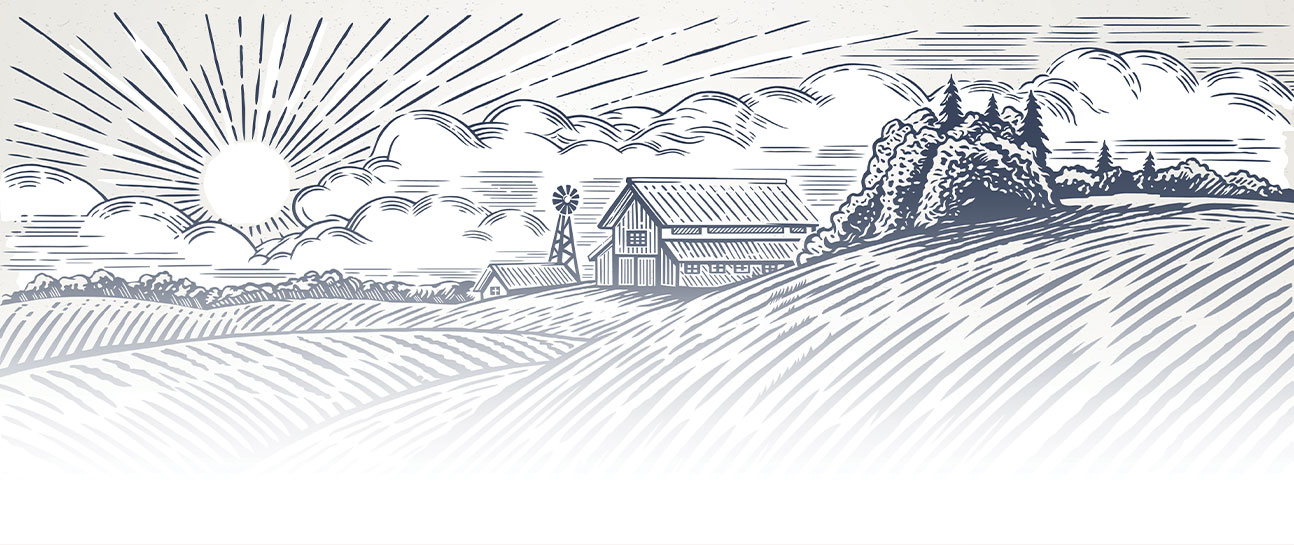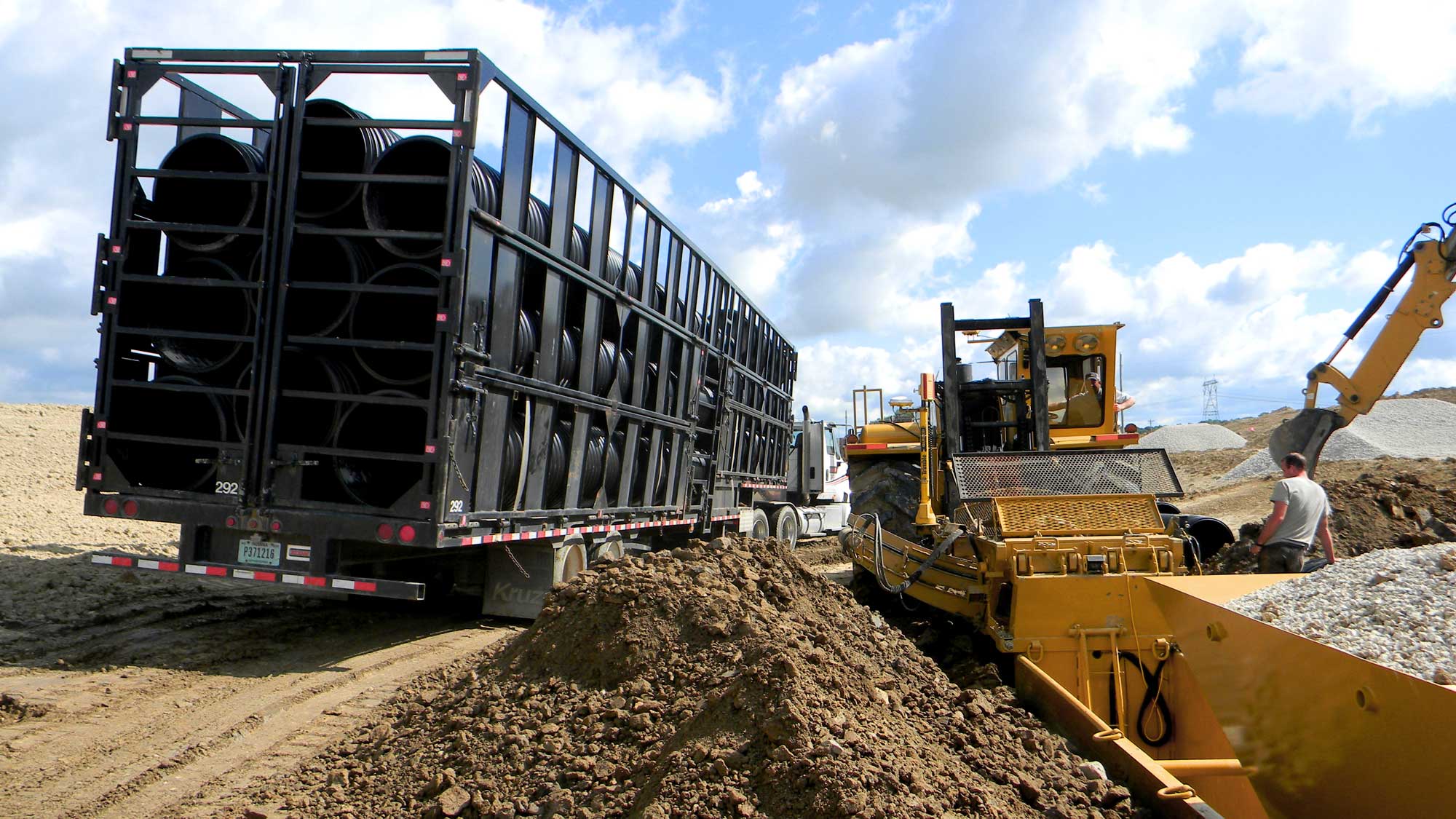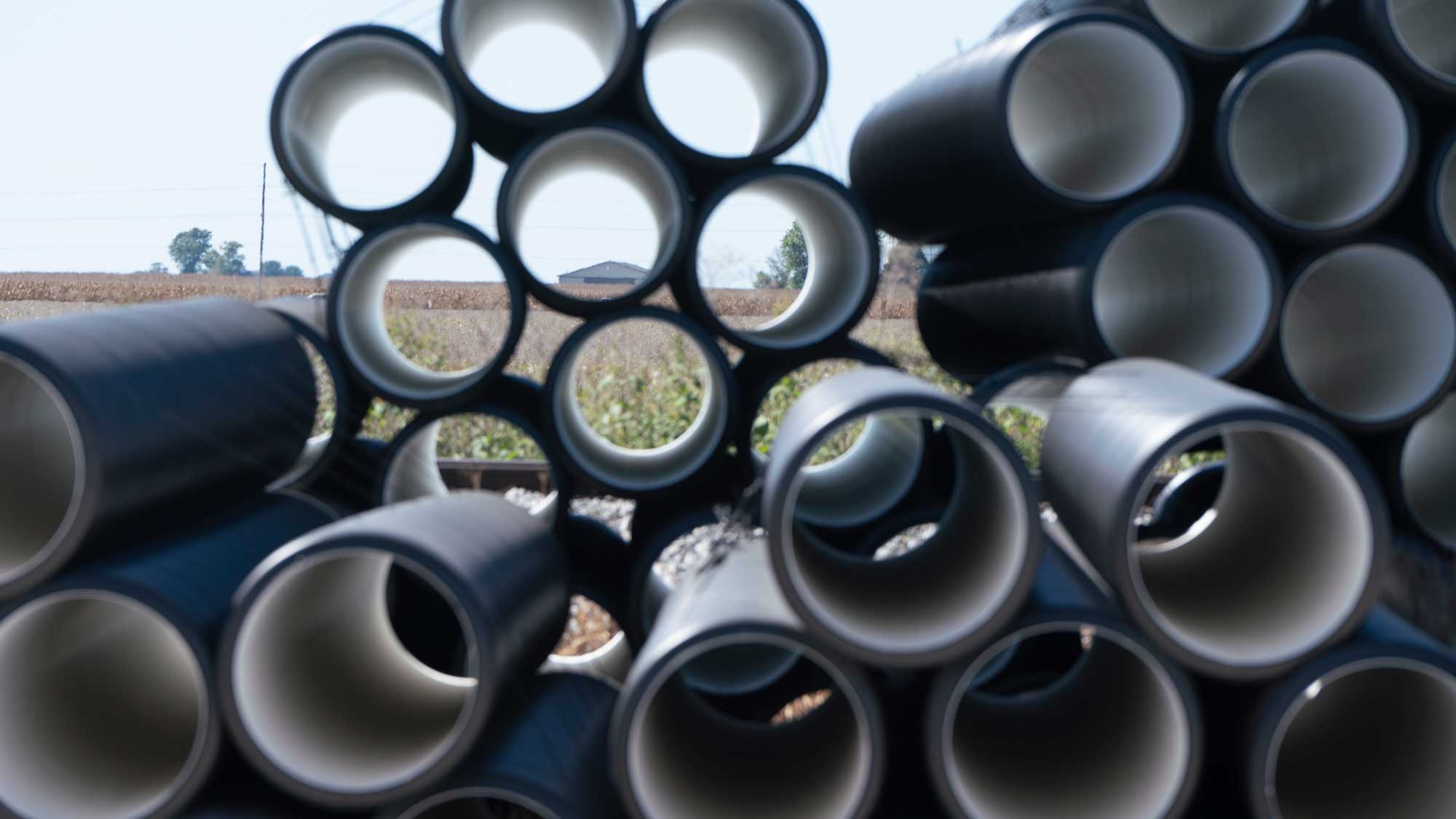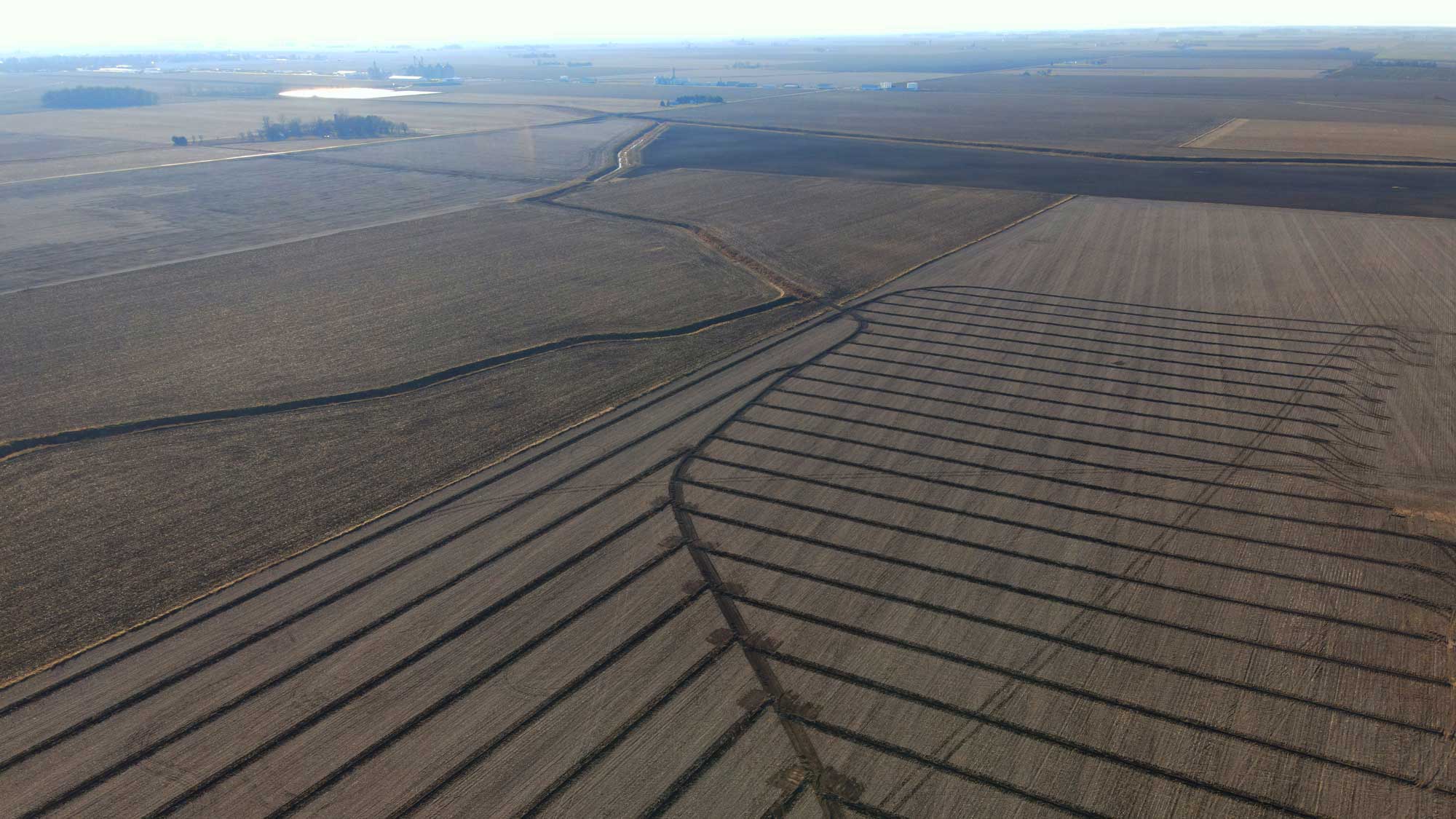As seen in the Tried & True Summer 2020 issue
Farmers feed the world. From sunrise to sunset, they care for the land, tend to animals and work hard to maintain what they steward. Pressures can mount when you consider what providing food for the planet means. From readying crops for harvest and keeping livestock healthy to looming drought and wringing hands over commodity prices at the market, these concerns barely scratch the surface of what growers and producers face every day. Is it any wonder that those responsibilities can feel, at times, like carrying 100 yards of pipe alone?
When it comes to the business of water drainage solutions, many hands work together to get the job done. Farmers work with contractors to plan the perfect time to leave as little disruption to the growing season as possible. Construction projects hum like clockwork, meaning pipe delivered and installed quickly equals staying on schedule. Every day, Fratco teams work around the clock to engineer, load, and ship products to customers. This is the day-in and day-out of what we collectively do because water stops for no one. When unique obstacles disrupt how we do business, what’s the best way to rise and weather the challenges before they happen? While maneuvering through current events, it’s not out of the ordinary to look towards history for guidance. We’ve been here before as a nation. This isn’t the first time hardship has stretched across the United States. History points us towards times when novel situations interrupted business as usual: famines, drought, economics, politics and pandemics.
In 1918, influenza hit the United States. Experts with their finger on the pulse of economics’ role in history see patterns from the past in what we face today with COVID-19. Thomas A. Garrett wrote a lengthy report in 2007 titled, Economic Effects of the 1918 Influenza Pandemic: Implications for a Modern-Day Pandemic. Garrett, a former economist and assistant vice president for the Federal Reserve Bank in St. Louis and current economics professor at the University of Mississippi, details the time’s happenings. The former ag professor notes that not all, but some areas of the United States differed in the degree and severity of the flu’s impact. Houses of worship and schools closed. Not everyone was immune; even the healthiest of people succumbed to the illness. While demand for some products and services increased, many businesses shuttered. Manufacturing plants saw influenza take a toll on their workforce as World War I summoned a large amount of the male workforce away. Transportation, communication, and life as it was known came to a grinding halt. The hardest hit? Those who depended on hourly wages—such as miners—to support their families.
It’s important to highlight once more that Garret’s work was published in 2007—thirteen years before COVID-19 became a global pandemic. Garrett also mentions that during the influenza pandemic, largely populated areas had more access to healthcare but also reported more illnesses. Parts of the country opened faster than others. Entertainment venues, such as movie theaters and concert halls, suffered closures. Restaurants boarded their doors. Frontline healthcare and service workers in good health were in demand and saw salary increases. As a nation, we’ve suffered tragedies and setbacks, yet we’re never down for long. However, one can’t help but see the way Garrett’s piece of scenarios past reads like a crystal ball of events today.
Mother Nature can be quite the catalyst for reexamining how we do business.
The business of water drainage threads us together. Some of us make and deliver pipe, others install and educate about its function and many benefit from the relief of knowing their fields and sites are water-logged no more. We are all a part of this industry; together. That’s why it’s essential to put the past and current events in perspective now. They provide a blueprint for becoming as business-resilient as possible for the “just in case” times ahead.
What’s the plan? Well, good question. Depending on your location and line of work, your roadmap could be different and multilayered from the next. Yet one thing rings true, no matter what. Know how to take action quickly so your essential part of the industry—your business—can adapt.
ASSESS AREAS OF UNCERTAINTY
You have a way of doing things, a traditional business model that works. Fine-tuned resources and processes, customers are happy, installs are happening, and client referrals are on your desk. It can be challenging to assess what areas are possibly prone to weakness until the alarm sounds. Step out of the comfort zone and honestly assess vulnerabilities. You may benefit from an honest and thorough outside look into your operation from a consultant or trusted cohort. Never be in the position where you have to communicate to your clients or employees that you have no idea how to help yourself, or them, to move forward. Try to see the unforeseen circumstances. Remember, hiccups happen. Not having a plan is no plan at all.
REMAIN OPERATIONAL
If you live in an area of extreme weather or have recovered from an unfortunate event, chances are you’ve sketched out a way through volatile times. Not only on how to regroup but also to keep business going in case of an emergency. Mother Nature can be quite the catalyst for reexamining how we do business. You have customers to care for, job sites waiting, or perhaps land demanding your attention. While examining the bare bones of your operation, outline a plan that keeps your doors open to the best of your ability. Take a realistic look at specific disturbances: temporary layoffs, essential functions, unavailable management and workers, supply chain disruptions, outside assistance, product reserves, cash flow, making payroll, and the other items pertinent to your business. Planning for “just in case” is smart. It means you’re looking ahead. Plans are not just for pandemics. They provide around- the-clock peace of mind. No matter what arrives at your doorstep, there’s less of a scramble to determine what happens next.
WHERE TECH CAN BE AN ADVANTAGE
Much of our business begins with a firm handshake on-site with customers. Walking the fields and operation of a farm with owners speaks volumes about their business, personal goals, and why they’re committed to growing for neighbors near and far. It’s part of relationship building. But what about new clients? Video conferencing provides a meet- and-greet avenue to put a face with a name. Is it the same as walking the job site and chatting over a cup of coffee? It’s not, yet it’s a solution to your customers’ need for service and yours to keep business rolling. Make contracts and billing safely available to clients online. Ensure your software provides an excellent and as authentic a look as possible at what their system will look like once installed. Being available, in multiple ways, is one of the most important facets of all.
MAKE THE BUSINESS PIVOT TOWARDS DIVERSITY
How can you create more business opportunities? During COVID, some restaurants moved from serving meals to providing fresh produce. Manufacturing lines paused regular production to make anything from personal protective equipment (PPE) to hand sanitizer. Farmers looked for ways to cut out the middleman and begin selling their product directly to consumers. Contractors took precautions out in the field to keep jobs moving. Look into ways you can add depth and breadth to your business. Adding areas of growth now may make all the difference later. Is there an add-on service you could offer? Could adding a new staff member or creating a new position take tasks off overloaded plates, freeing up others to be more productive? Consider cross-training crews and employees for different jobs. That means less time needed to learn new roles during a critical time. You may also open a window of opportunity for someone to try something new, leading to better employee retention. If someone loves what they do, productivity increases—a win for everyone.
DON’T WAIT TO HAVE A PLAN IN PLACE
Time will dictate how we all move forward after COVID-19, yet we know we’ll continue doing it together. As an industry, we strive to help one another. Not just during the tough times, but any time help is needed. We’re already a pretty resilient bunch used to long days, hard work, and getting it right. Planning out a strategy to remain resilient means you’re invested not only in your business but also in those alongside you. Don’t wait to have a plan in place. Be effective now before an extraordinary situation heads your way again.











